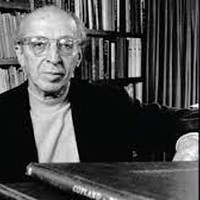Copland's Appalachian Spring

Sponsored By
- February 27, 2016


Sponsored By


The initial inspiration for this piece came from Frank Lloyd Wright’s stained glass window designs, which he termed “light screens.” These designs use simple shapes like the square and the rhombus in repetitive patterns, and they often feature a lively dynamic of asymmetry between areas of intense geometric activity and expanses of largely empty space.
Light Screens was originally written for flute and string trio. It was later transcribed for string quartet and taken up by the Ives and Cassatt Quartets.
Andrew Norman ©2002
 Listen to Audio
Listen to Audio
In the wake of two well-received ballets set in the American West — Billy the Kid (1938) and Rodeo (1942) — Aaron Copland began Appalachian Spring in 1943. He created the ballet for the dancer and choreographer Martha Graham, and he worked under the title Ballet for Martha until not long before the premiere, when Graham suggested Appalachian Spring, borrowing a phrase from Hart Crane’s poem “The Bridge.”
Created for the 500-seat auditorium at the Library of Congress in Washington, DC, this ballet needed a suitably compact pit orchestra, so Copland used just thirteen instruments in the original version. The next year he arranged most of the ballet into a concert suite for orchestra, and his publisher later added the option heard here, which preserves the original chamber ensemble scoring while adopting the structure of the concert suite.
The wonder of Appalachian Spring is how it achieves so much using such simple and familiar musical ingredients. The first section assembles its hazy wash of consonant sonorities by enunciating plain triads and the resonant intervals of fourths and fifths. The following section energizes similarly basic materials — octave leaps, triadic intervals and descending major scales — into spry dance music. There is a tender scene for the young couple, a lively romp depicting the revivalist and his dancing minions, and then a brisk solo dance for the bride, which dissipates into a return of the gentle, triadic wash of the beginning.
The famous section that follows, starting with a theme in the clarinet, presents the tune of Simple Gifts, a Shaker dance song written in 1848 by Joseph Brackett. The humble melody fits seamlessly into the homespun, diatonic language of Copland’s score, and its increasingly grand variations rise to a transcendental climax.
Aaron Grad ©2024
 Watch Video
Watch Video
Wolfgang Amadeus Mozart composed Concerto No. 24 during his fourth season in Vienna at a time when he was gaining rapid renown as a pianist and composer of concertos. Concerto No. 24 was premiered in April 1786 at the Viennese Burgtheater, with Mozart himself playing the solo part and conducting the orchestra from the keyboard. Ludwig van Beethoven was tremendously impressed by the work, and Johannes Brahms later wrote that this concerto was a “masterpiece of art and full of inspired ideas.”
The extensive first movement of Concerto No. 24 repeatedly defies the listener’s expectations by challenging conventions of structure and harmony. Most concertos from this time period open with a straightforward melodic theme that clearly defines the key of the piece within the first few measures. The first theme of Concerto No. 24, however, boldly contains all twelve chromatic pitches, and the home key of C minor remains ambiguous until measure thirteen. Likewise, in many of Mozart’s other concertos, the first solo entrance begins with the same music played by the orchestra at the opening of the movement. In Concerto No. 24, the pianist instead enters with a lengthy passage of new musical material.
The development section of the first movement features a particularly turbulent, passionate, and operatic dialogue between the pianist and the orchestra before leading into a more conventional recapitulation of the opening themes. Boundaries are broken once more in the coda at the very end of the movement, as the pianist unexpectedly interrupts the orchestra for a final virtuosic solo moment.
One of the defining sonic features of Concerto No. 24 is Mozart’s imaginative and unusual use of both oboes and clarinets. Throughout the piece, the winds have important moments where they take precedence over the strings. This is especially noteworthy in the tender Larghetto. With its elegant phrases, simplistic themes, and predictable ABACA rondo structure, this movement provides an exceptional contrast to the tumultuous first movement.
Concerto No. 24 concludes with a theme and variations, which begins with a straightforward orchestral statement of the theme. Each of the eight variations inventively incorporates rhythmic, harmonic, textural, and/or melodic contrast, with the final variation and coda bringing the whole concerto to a triumphant close.
Operatic drama permeates Piano Concerto No. 24, which was written shortly before Mozart’s Le nozze di Figaro premiered. In fact, Mozart would shortly thereafter become known more as an opera composer than as an instrumental composer and performer.
Paula Maust ©2022
Get driving directions and find nearby parking.
Find dining options close to the venue.
View seating charts to find out where you'll be seating.
SPCO concerts are made possible by audience contributions.
For exclusive discounts, behind-the-scenes info, and more:
Sign up for our email club!
